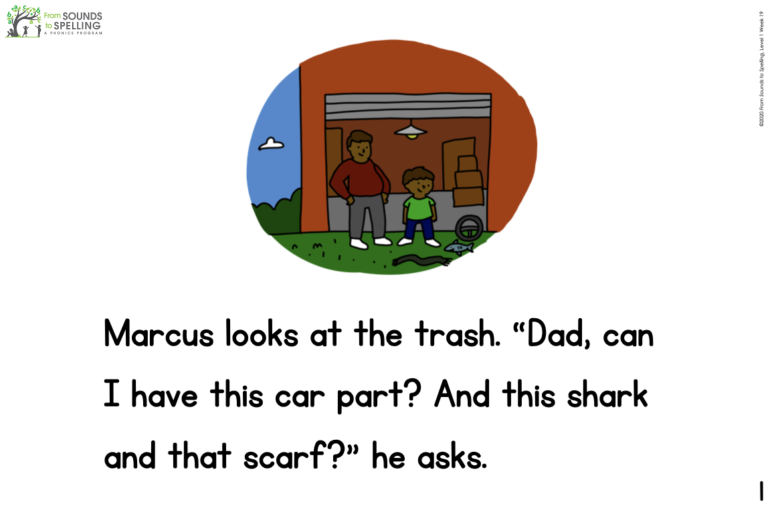
What Are Decodable Readers or Decodable Texts?
Decodable readers or decodable texts can be a powerful tool in early reading instruction.
They are texts that are controlled for specific phonics patterns. For example, a decodable text might include lots of words with digraphs "ch," plus review with short vowels and CVC words that students have previously learned.
Decodable books also often include high frequency words (sometimes called "sight words").
The purpose of decodable books is to give students practice with the phonics patterns you’re teaching them. They provide an excellent opportunity for in-context practice. (Students need to practice phonics patterns and words in isolation, as well as in the context of reading and writing.)
Here’s an example page from a decodable book in our phonics program, From Sounds to Spelling:

This page comes from a week focused on the r-controlled vowel “ar.” The words “Marcus,” “car,” “part,” “shark,” and “scarf” all include this target spelling pattern.
All other words on this page have been previously taught OR they include phonics patterns that have been covered during previous weeks. With decodable texts, it’s important that students can decode the majority of the words in the text. (If there are any words that students won't be able to decode, simply pre-teach them before they read the book.)
Watch this video to learn more about some tricky nuances related to decodable texts:
What Does A High-Quality Decodable Book Look Like?
We recommend using decodable books that:
- Are engaging for students
- Match the phonics patterns that you’re teaching
- Sound natural
- Lend themselves to meaningful discussions
Of course, decodable books by themselves aren't enough for teaching students how to read and think deeply about texts. Read-alouds are another important part of early literacy instruction.
How to Use Decodable Books with Students
The primary purpose of using decodable books is to give students practice with the phonics patterns they’re learning. Other goals are to provide practice with high frequency words, work on comprehension, and improve fluency.
With a decodable book, have students:
- Circle or highlight words with a target phonics pattern (this can be done before or after reading the text)
- Discuss the meaning of the text
- Read the text multiple times, for fluency development
- Respond to the text in writing, i.e. by answering a question or by writing about the beginning/middle/end
Decodable books can be used successfully in a small group setting, but they can also be used to teach whole group lessons.
You can use decodable books to model the decoding process for a new pattern. You can also use leveled decodable books for students to partner-read or read independently.
Where Can I Find Decodable Books?
Many phonics programs do not include enough - if any - decodable texts for students. We believe that teachers should not have to search far and wide to find texts where students can practice their decoding skills in decodable books.
In our phonics program, From Sounds to Spelling, there are typically 2 decodable books / passages included per week (with the exception of Kindergarten, when students are not yet reading).
The majority of the texts in the program also include 2 different levels – the “regular” level and an “easier” level. The easier version of each text typically includes shorter sentences, fewer challenging words, and (when applicable) fewer multi-syllabic words. The different difficulty levels will help you accommodate the variety of readers in your clasroom.
To learn more about how From Sounds to Spelling helps build students’ phonological awareness, phonics, and early reading skills, click here. Make sure to look for the “free trial” button so you can get a free week of materials (including decodable texts), plus a free diagnostic assessment and scope and sequence!




